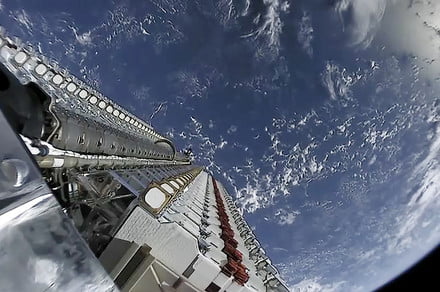[vimeo 338361997 w=640 h=360]
The last time we saw SpaceX’s 60 internet satellites was on Thursday night, May 23, when they were just beginning to fan out high above Earth, marking the start of the company’s ambitious Starlink program.
Almost immediately, enthusiastic satellite trackers such as Netherlands-based Marco Langbroek began searching the sky to seek out the “train” of newly launched satellites. Much to his delight, Langbroek not only located the Starlink satellites, but also snagged some amazing video footage (above) of them orbiting the planet at an altitude of about 273 miles (440 km).
The skywatching community used various tools to work out the orbit and position of the satellites, enabling trackers like Langbroek to locate them as they passed overhead.
“It started with two faint, flashing objects moving into the field of view,” Langbroek wrote in a blog post describing the moment he spotted the satellites, adding: “Then, a few tens of seconds later, my jaw dropped as the ‘train’ entered the field of view. I could not help shouting ‘OAAAAAH!!!!’ (followed by a few expletives…).”
Langbroek said he shot the video using a Watec 902H low-light-level surveillance camera with a Canon FD 1.8/50 mm lens.
“Over the coming days the train of objects will be making 2 to 3 passes each night,” he wrote, adding that because the satellites are actively maneuvering with their ion thrusters, “they will be more spread out with each pass, so the train will probably quickly dissipate.”
SpaceX’s 60 Starlink satellites shortly before being deployed on May 23, 2019. SpaceX
Last week’s SpaceX mission, which launched from Cape Canaveral in Florida, was the first big step for Musk’s ambitious Starlink project aimed at beaming cheap broadband across the planet.
Over the next eight years, the company plans to send as many as 12,000 of the satellites into low-Earth orbit to complete its system, although SpaceX CEO Elon Musk has said a limited service could start as soon as 2020 if the team can stick to its schedule of launching at least 1,000 satellites a year.
The entire Starlink project is expected to cost in the region of $10 billion, a sum that includes launch costs, as well as the design and setup of the necessary infrastructure to create the global broadband network.
But SpaceX is competing with other companies aiming to build a similar kind of service, with Facebook, Amazon, and SoftBank-backed OneWeb, among others, working on their own separate projects.
Editors’ Recommendations
- SpaceX joins internet-from-space race with launch of 60 Starlink satellites
- This is what 60 SpaceX internet satellites packed into a rocket look like
- Watch live as SpaceX tries, for the third time, to launch 60 Starlink satellites
- SpaceX calls off Starlink launch just 15 minutes before liftoff
- Planet-hunting satellite discovers its first Earth-sized planet

